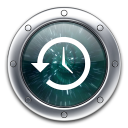Howto Mac OS X Time Machine Backup to a Network Drive
- October 13th, 2011
- By Zerga
- Write comment
 I do not own a Time Capsule, I do not plan to get one, nor do i want to connect a usb disk every time i feel like making a backup of my stuff. What i do have however is a wireless network and a Windows 7 PC. Why not use the available disk space in my PC for the backups of my Macbook Pro? I found out how to Time Machine Backup to a Network Drive…
I do not own a Time Capsule, I do not plan to get one, nor do i want to connect a usb disk every time i feel like making a backup of my stuff. What i do have however is a wireless network and a Windows 7 PC. Why not use the available disk space in my PC for the backups of my Macbook Pro? I found out how to Time Machine Backup to a Network Drive…
In Snow Leopard it was still possible with a few tweaks and manual image file creation to get the OS to actually backup over the Network onto a Windows NTFS disk. Hoozah! In Lion (MacOSX 10.7.2) there is even another step required to get the backup process running. Using just step 1 it will fail with the message ‘The network backup disk does not support the required AFP features’.
1. So besides the same steps as in Snow Leopard to prepare the Backup Image File (my previous post) you will also need to…
2. Download and run the script from this file to modify backupd in such a way that it accepts remote disk on the network share: backupd_anyafp_r2 – just unpack and run ./install.sh from the terminal.
Thanks to msft.guy for the script!
PS: I still get the feeling that the backup of a FileVault encrypted home directory even on Lion still doesn’t work while being logged in. Meh.
Correction: I had to switch to FileVault2. Now the whole disk is encrypted and my guess is Time Machine can handle that…
What if I still can’t find my share in TimeMachine?
(added 24. Jan. 2013)
Here is a checklist what I would try then:
- close the preferences or even reboot after running the script above.
- Find out your Computer Name:
- Go to Apple menu > System Preferences and click Sharing.
- Note the computer name appearing at the top of the window.
– For example “ZergasMacbook”.
- Find your MAC address:
- In Apple menu, select
System Preferences... - From the
Viewmenu in System Preferences, selectNetwork. - In the left column of the
Networkpreference window that opens, click the name of your connection (EthernetorBuilt-in Ethernet). - Click the
Advanced...button, and in the dropdown, click theHardwareorEthernettab. - The address is the string of letters and numbers next to “MAC Address:” or “Ethernet ID:”.
– For example “00:15:20:aa:fe:a1”.
- In Apple menu, select
- Create your sparsebundle:
- Follow the steps described in my guide: Create a sparsebundle on your Mac manually with the name “ComputerName_MACaddressWithoutColons.sparsebundle” and move it into the shared folder on the windows machine.
– In the case of the examples above it would be “ZergasMacbook_001520aafea1.sparsebundle”.
- Follow the steps described in my guide: Create a sparsebundle on your Mac manually with the name “ComputerName_MACaddressWithoutColons.sparsebundle” and move it into the shared folder on the windows machine.
- Connect to the share:
- On your Mac, in Finder go to the menu Go -> Connect to Server…
- Choose the share with the sparsebundle in it on your Windows computer. The share will now be mounted under Volumes with the name of the share folder you gave in windows.
– For example let’s call the directory “MacBackup” on the computer “WindowsPC” then you a folder on your Mac called “/Volumes/MacBackup”.
- Mount the sparsebundle:
- Open a terminal and mount the sparsebundle as a drive under /Volumes on your mac by typing: hdiutil attach -verbose /Volumes/MacBackup/ZergasMacbook_001520aafea1.sparsebundle
You can also just double-click on it to mount (thanks, mike!).
- Open a terminal and mount the sparsebundle as a drive under /Volumes on your mac by typing: hdiutil attach -verbose /Volumes/MacBackup/ZergasMacbook_001520aafea1.sparsebundle
- Connect the sparsebundle:
- Now add the sparsebundle as the Time Machine destination with the terminal by typing: sudo tmutil setdestination /Volumes/mounted_sparse_bundle
- Then try starting the preferences and go to TimeMachine looking for the sparsebundle again.
BTW: In the terminal you can hit TAB and OSX will complete the name of a file or folder you were about to write. Like this you dont have to type all the sparsebundle file name.
Good luck!